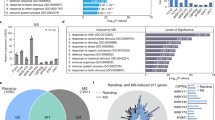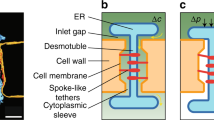Abstract
SNOW1 has confirmed my discovery that the propagation of stimuli in the stem of the so-called Sensitive Plants is due to the transport of a hormone in the water of the tracheæ.2 He, however, comes to the conclusion that in the leaves there is another and more rapid means of conduction of stimuli. This function he provisionally assigns to protoplasmic processes.
This is a preview of subscription content, access via your institution
Access options
Subscribe to this journal
Receive 51 print issues and online access
$199.00 per year
only $3.90 per issue
Buy this article
- Purchase on Springer Link
- Instant access to full article PDF
Prices may be subject to local taxes which are calculated during checkout
Similar content being viewed by others
References
Proc. R.S., B, 1924, vol. 96, p. 349; 1925, vol. 98, p. 188; NATURE, 1925, vol. 115, p. 82.
N. Giorn. Bot. Ital., 1916, vol. 23, p. 51; résumé in Arch. Ital. de Biol., 1916, vol. 65, p. 219.
NATURE, 1925, vol. 116, p. 376; Proc. R.S., B, 1925, vol. 98, p. 290.
Bot. Gaz., 1896, vol. 22, pp. 296, 297.
Beitr. z. allg. Bot., 1923, vol. 2, pp. 260–262; Zeitschr. f. Bot., 1925, vol. 17, p. 260 and p. 261. I am informed that, also in Oxford, the passage of a stimulus across an organic discontinuity in the stem has been demonstrated.
NATURE, 1924, vol. 114, p. 626.
“Das reizleitende Gewebesystem der Sinnpflanze”, 1890, p. 36.
Jahrb. f. wiss. Bot., 1904, vol. 39, p. 511.
Author information
Authors and Affiliations
Rights and permissions
About this article
Cite this article
RICCA, U. Transmission of Stimuli in Plants. Nature 117, 654–655 (1926). https://doi.org/10.1038/117654a0
Issue Date:
DOI: https://doi.org/10.1038/117654a0
This article is cited by
-
Untersuchungen über die Feinstruktur und die Funktion der Plasmodesmen vonVolvox aureus
Planta (1964)
-
Der elektrische Faktor des Wassertransports im Lichte der Vitalfärbung
Ergebnisse der Physiologie (1930)
Comments
By submitting a comment you agree to abide by our Terms and Community Guidelines. If you find something abusive or that does not comply with our terms or guidelines please flag it as inappropriate.



